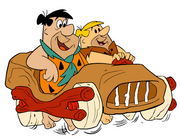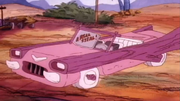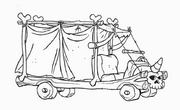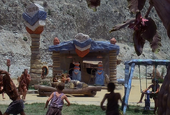Cavemobiles (or simply Cavecars) are the main mode of transportation in the modern Stone Age among cavemen and serve as the iconic vehicles featured in the Flintstones franchise by Hanna-Barbera.
Background[]
Cavemobiles are wheeled vehicles usually made from either stone and/or wood, with the most common feature being an interior or outer frame made of wood that holds the whole thing together and the body of the car itself which is usually stone that's been carved into various shapes to offer a wide variety of models for drivers to choose from. The wheels are just as varied, usually either being four separate small rock-wheels or flat sawed off log-wheels, or instead having two large roller rock-wheels.
Power, Engine and Breaks[]

An example of stone age foot power at work with Fred and Barney.
Cavemobiles are mainly started and kept going by good old fashioned foot power. The faster one goes, the faster the cavemobile can go while offering seated comfort to its passengers.

A mini-dino engine getting refueled from "Amusement Park".
Many cavemobiles have built-in lizardsaurus or mini-dino engines that are kept going with dino-fuel so only some foot power is required to start up the cavemobile while the engine takes care of the motion from there, with it only stopping by putting one's feet down on the ground as the feet of the driver (as well as the passengers) are the primary break and emergency break. If the cavemobile runs out of gas or more speed is required, the auxiliary engine (i.e. the feet) is always ready to give it an extra push.
In the case of larger vehicles, such as buses or limos, it is required that both the driver and passengers put their feet to work in order to get the heavier vehicle started up. The drawback to having one's own feet also serve as the break is the risk of getting the old hotfoot now and then.
Dino-Fuel[]

A stone age gas station from "Droop-Along Flintstone".
Dino-Fuel (or simply Gas) was the main fuel source for cavemobiles. In truth, dino-fuel was simply water which was used to either hydrate their thirsty dino motor, and coolant was also just water used to cool and clean off the driver's feet while antifreeze was simply hot soup used to warm up dinosaurs during winter.

Fred giving his bronto-crane anti-freeze soup from a January 1, 1966 comic strip.
Gas stations were common throughout the modern stone age, usually managed by one or two attendants and mechanics and the dino-fuel was stored in large mammoths which acted as tanks (although regular tanks made out of stone would make rare appearances) and who would then fill up the cavemobile's gas tank with their trunks. Usually one of these mammoths was commonly named Ethel (a joke on Ethyl gasoline). Such stations offered to clean and check up cavemobiles too, and whenever a cavemobile arrived on the driveway, attendants would instantly be alerted by a lizardsaurus bell ringer.
Classes (in alphabetical order)[]
There exist many models of cavemobiles, each suited with particular tastes and sizes in mind, with some being made with single drivers in mind while others are made with whole families in mind.
Allosaurus[]

An Allosaurus.
A stylish and open-air four-seater cavemobile model with a low double-log frame and built-in engine. A sleek and comfy vehicle designed for group outings in mind. A three-wheeler with two rock-wheels at the front and a roller in the back. Named after the allosaurus.
Anatosaurus[]

An Anatosaurus.
A stylish and conservative two-seater model with a solid single stone body that could fit up to two people. Had built-in headlights and wooden wheel hubs. Mainly a three-wheeler with two rock-wheels at the front and one roller in the wheel. Named after the duck-like anatosaurus.
Bugasaurus[]

A Bugasaurus.
A small four-seater vehicle with a stone frame that is visually inspired by the simple body of a bugasaurus, hence its name. It comes with three wheels in total, two small rock-wheels in the front and one large roller in the rear. One of the few models built to be complete enclosed for max protection from the elements and equipped with built-in headlights.
Cadirock[]

A Cadirock from "The Fugitives".
A sleek open air model that featured a distinctive tusked bumper and a double-log frame that ended in sharp tailfin patterns, making it a very stylish cavemobile. With built-in spotlights, dino-fuel engine and even its own owlasaurus alarm, this car was ahead of the curve. A four-wheeler with flat rock-wheels. It appeared in both episodes, "Mr. Big" from The Flintstone Comedy Show and "The Fugitives" from The Flintstone Kids.
Canopysaurus[]

A Canopysaurus.
The ever stylish and comfortable canopysaurus is a sturdy double-logged frame with comfortable slab seats that offer comfort and wide sitting ranger for as many as up to six passengers, plus room leftover for pets and infants. With its built-in wooden and cloth canopy, it offers plenty of protection from the heat, rain and pterodactyl droppings, while still having a porthole in the back for monitoring rear-end traffic. It is a trusty two-wheeler with two sturdy rollers. It even comes with a trunk big enough to store a third spare-wheel or any other necessities. Fred's Flintmobile is the most iconic example of a canopysaurus.
Cariama[]

A Cariama.
A sleek one-seater model with a small double-log frame and solid stone body with a built in engine vent and wooden and cloth canopy for those sunny days. Perfectly suited for those speeding loners on the go. A three-wheeler with two rock-wheels at the front and one roller in the wheel. Named after the crested cariama bird.
Diatryma[]

A Diatryma.
A small and conservative two-seater model with a solid single stone body with a built-in wooden and cloth canopy that could fit up to two people. Mainly a three-wheeler with two rock-wheels at the front and one roller in the wheel. Named after the diatryma, a flightless bird.
Geosaurus[]

A Geosaurus.
An older open-air model with an elevated design with a small log frame and double-rock body and one of the few models with a built-in engine, with a rock hood for the engine and a second larger rock frame for the driver and passengers that could fit up to four people or more. Named after the aquatic geosaurus.
Logrover[]

A Logrover.
A simple compact and conservative model that consists solely of a single wooden log frame with a small trunk that can also serve as a seat, along with four rock-wheels. Capable of fitting up to three passengers. It also comes with a canopy attachment. Barney's Loggin Continental is the most notable and iconic example of this class.
Packasaurus[]

A Packasaurus.
A classic yet simple open air model with a double-log frame and a classy and durable turtlesaurus-shell hood that also serves as a bumper, making it a safe vehicle all around. Fitted with two wide stone seats that can fit up to four or five passengers. Equipped with three wheels, two small rock-wheels on the front and one large roller-wheel in the rear.
PH Hearse[]

A PH Hearse.
A large canopy-model cavemobile that is mostly employed by funeral homes and used for formal funeral services to escort coffins. However these cavemobiles also enjoy civilian use, being popular with jovially creepy denizens from Rocksylvania, such as the Gruesomes and the Frankenstones, both of whom own their own unique model hearses, with the Frankenstones' model even featuring a prominent skeletal and skull motif which is considered quite popular in their circles.
Raptoroadster[]

A Raptoroadster.
A four-seater stone model with a small wooden frame concealed by an entirely stone body. Complete with rare built-in headlights, wooden and cloth canopy and engine vent, making it quite the item. Designed with speed and comfort in mind, it is a popular choice among drag-racing youths. A three-wheeler with two rock-wheels at the front and one roller in the rear. Named after the speedy velociraptor.
Rockerrari[]

The Rockerrari Special from "Jealousy" with Wilma and her old boyfriend, Wilbur.
Known as the Rockerrari Special, it is a luxurious, sleek and comfortable two-seater model with a completely stone frame with the exception of a wooden hub and wooden engine vents, and it includes a built-in wood and cloth canopy with a bone-frame and two roller wheels. It only appeared in the episode, "Jealousy" with Wilma and her old boyfriend, Wilbur riding on it. Note that it was spoofed after the Ferrari and modeled after the most popular and original Dino vehicle models.
Scolosaurus[]

A Scolosaurus.
A sleek two-wheeler with a completely stone frame with the exception of the wooden wheel hubs and wooden engine vents. A sturdy solo dragster built with speed in mind, its perfect for the lone wanderer and racer on the go. It even comes with plenty of storage space in the trunk. Named after the hardy scolosaurus.
Stego[]

A Stego.
A small and conservative four-seater model with a solid single stone body with a built-in wooden and cloth canopy that could fit up to four people. Mainly a three-wheeler with two rock-wheels at the front and one roller in the wheel. Its name and frame is inspired by the trusty stegosaurus.
Therapsida Coup[]

A Therapsida Coup.
One of the few models built to be complete enclosed for maximum protection from the elements and equipped with built-in long range headlights. Its design and frame were inspired by the humble therapsid.
Theroped 100[]

A Theroped 100.
A closed doorless stone model with a completely stone frame. The seats are carved into the vehicle itself along with an engine vent, and it includes a built-in wood and cloth canopy with an open rear. A sturdy three-wheeler with two wood-wheels at the front and a rock-roller in the rear. Named after the theropod family of which tyrannosauruses and allosauruses belong to.
Tricer[]

A Tricer.
The simple and small tricer is an affordable compact model however it can still fit up to four people and its comfortable slab seats, with the rear seats even being capable of functioning for storage if need be. A sturdy double-log frame keeps the whole thing together and remains a sturdy three-wheeler, with two rock-wheels at the front and a log-roller in the back. Named after the triceratops.
Ultrasaurus Coup[]

An Ultrasaurus Coup.
A sleek and compactable two-wheeler with a completely stone frame with the exception of the wooden wheel hubs and wooden engine vents. A three-wheeler with two rock-wheels at the front and one roller in the wheel. Named after the giant ultrasaurus.
Gallery[]
Notes/Trivia[]
- Many of the names for cavemobile models are based on real car model names mixed with names of prehistoric animals or rocks.





















